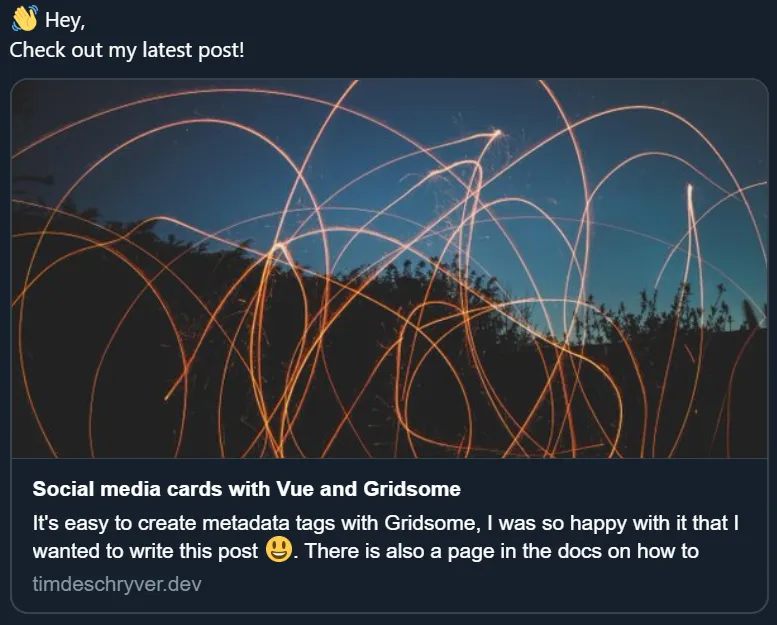Social media cards with Vue and Gridsome

Social media cards link
With a social media card it is possible to transform a simple (and boring) link when you share it on different platforms, like Twitter or Slack, to an eye-catching message. The message contains a title, a description and an image if provided. To create social media cards for a website we have to add a couple of metadata tags inside the header tag of the page. When we're promoting our website, let's take a blog for example, we could provide the metadata tags. We could even take it a step further and create these metadata tags for specific pages. If we want to distinguish a post from our blog and from the other posts within it, we must have a custom card for the said post. Therefor we must override the global metadata tags with metadata tags for the specific post.
The snippet below shows an example on how this looks like, as you can see, there are two different sets of metadata we have to provide. The first one prefixed by og: is the Open Graph standard and is used by Facebook, the second set of tags are prefixed with twitter: and these are the tags that Twitter uses.
You can read more about the usage of the above tags on the Open Graph protocol page and in the Twitter docs. It's also possible to validate the cards on Facebook and Twitter.
Metadata tags with Gridsome link
Global tags link
To define global metadata tags that are added on every page, use the default function inside src/main. To add a tag we must provide the tag's name and content, the key is optional but is needed if we want to have the option to override the tag later on on the other pages. If we don't add the key property and provide the same tag later, the tag will be added again for every time that the same tag is added. For keeping the next snippets small, I will only add one tag instead of all of them.
The tags being provided here will be all static content and in most of the cases they will use the key property. At this point we can also use the Vue router to create the og:url tag because we want this tag to point to the current URL and because we're lazy we don't want to add it manually for each page.
Page specific tags link
Gridsome works with pages, the docs defines a page as a static page with a static URL. For example /posts qualifies as a page.
format_quotePages are used for normal pages and for listing & paginate GraphQL collections. Like for example a Blog page. The URL path of a page is always static.
To add or override metadata tags use the meta property on metaInfo. Here again we provide a key when we define the metadata tags because we want to override the tags defined at the global level.
Dynamic tags in Templates link
A template in Gridsome is the same as a page but unlike a page it's dynamic. For example /posts/slug qualifies as a template.
format_quoteTemplates are used for single post views to GraphQL collections.
The usage of metadata tags together with dynamic templates can be a powerful combination. In my opinion, this is where Gridsome makes it easy and pleasant to work with.
The post's data comes from a GraphQL query and will be different for each post.
format_quoteFor more information see the Gridsome blog
The end result link
This is how it will look like if you tweet this post on Twitter

And if you share it on Slack, this is how it looks like

Feel free to update this blog post on GitHub, thanks in advance!
Join My Newsletter (WIP)
Join my weekly newsletter to receive my latest blog posts and bits, directly in your inbox.
Support me
I appreciate it if you would support me if have you enjoyed this post and found it useful, thank you in advance.
